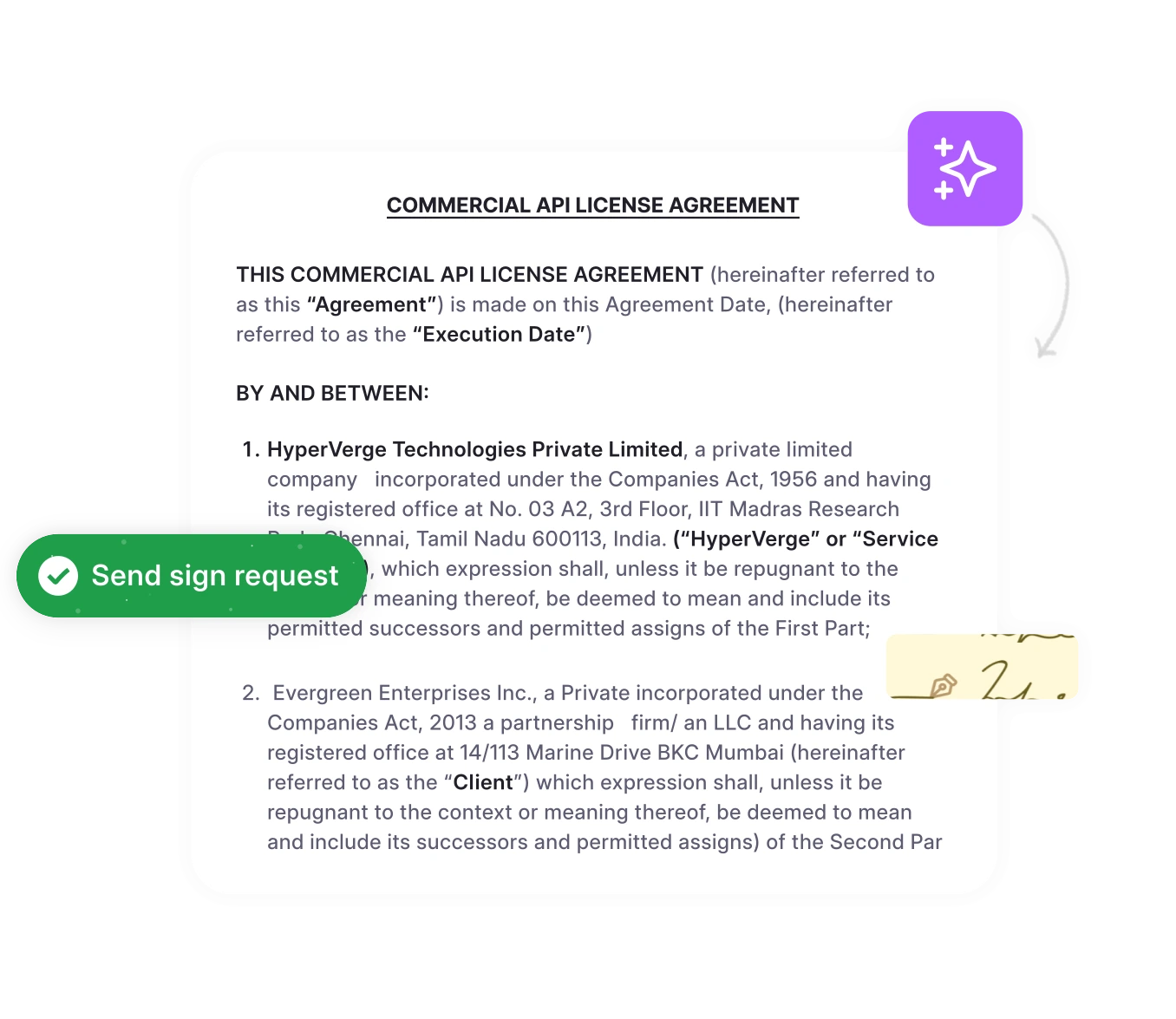Legal teams managing multiple vendor relationships face a common challenge: understanding when to use an MSA vs SOW. The confusion between these two contract types costs organizations time, creates compliance risks, and slows deal velocity.
The difference is that an MSA establishes the overarching legal framework for your business relationship, while an SOW defines the specific project details within that framework. Getting this distinction right means faster contract execution, reduced legal review time, and better vendor management.
In this guide, you’ll learn what a master service agreement is, what SOWs are, how MSA and SOW contracts work together, and best practices for managing both contract types efficiently.
What is a master service agreement (MSA)?
A master service agreement is a comprehensive legal contract that establishes the general terms and conditions governing a long-term business relationship between two parties. Rather than negotiating contract terms for every individual project, the MSA creates a standardized legal framework that applies to all future work.
“The Master Services Agreement (MSA) establishes a contractual framework for Supplier’s provision of services under Service Agreements worldwide.”
Read
What is the purpose of MSA?
The primary purpose of an MSA contract is to streamline ongoing business relationships. When your organization works with a vendor on multiple projects over time, renegotiating basic legal terms for each engagement becomes inefficient and expensive. The MSA solves this by establishing foundational terms once, then allowing individual projects to proceed under this pre-negotiated framework.
From a legal perspective, the meaning of the MSA in contract law is significant. It serves as the “master” agreement that governs the entire business relationship, providing consistency and reducing legal risk across all projects. MSA in business applications spans industries, from technology services to manufacturing. Understanding how MSAs fit within business contracts helps clarify their strategic importance.
Core components that every MSA contract should include
A well-drafted master service agreement includes several essential elements:
- Payment terms and invoicing procedures
Establish how and when payments will be made, including invoice submission requirements, payment schedules, and accepted payment methods.
- Liability limitations and indemnification clauses
Define each party’s legal exposure and responsibilities, including caps on liability amounts and obligations to defend against third-party claims.
- Confidentiality and intellectual property rights
Protect sensitive business information and establish ownership of work products, addressing non-disclosure obligations and IP ownership.
- Dispute resolution and termination provisions
Outline the process for resolving disagreements and the conditions under which either party can end the relationship.
- Insurance requirements and compliance standards
Specify the types and amounts of insurance each party must maintain, along with regulatory compliance obligations.
Why do legal teams rely on master service agreements?
Understanding what MSA means for legal operations reveals significant advantages:
- Reduced negotiation time: MSAs dramatically reduce contract negotiation time for subsequent projects. Instead of negotiating dozens of standard legal clauses for each new SOW, legal teams can focus on project-specific terms.
- Consistent risk management: Standard MSA templates enable consistent risk management across all vendor projects. When your legal team negotiates favorable terms once, those protections automatically apply to every project under that MSA.
- Improved vendor relationships: MSA contracting improves vendor relationship management by creating predictability and trust between parties.
Real-world example:
When LeadSquared, a fast-growing SaaS company, evaluated contract management solutions, they assessed 5 CLM vendors across 22 parameters. Their legal team needed a scalable MSA framework to manage multiple vendor relationships without renegotiating terms for every project.
By implementing standardized MSAs with their key vendors, LeadSquared’s legal operations team reduced contract negotiation time by 80% and could execute new SOWs in days instead of weeks.
Managing multiple MSAs?
See how HyperStart’s AI-powered contract management platform streamlines the whole process for you.
Book a DemoWhat is a statement of work (SOW)?
A statement of work is a project-specific contract document that defines the scope, deliverables, timelines, and costs for a particular engagement. While the MSA establishes the general legal framework, the SOW provides the tactical details of what will be delivered, when, and the associated costs.
“The Statement of Work (SOW) governs and provides direction for the conduct of the project and should address all key aspects, defining who, what, when, where, why, and how.””The Statement of Work (SOW) governs and provides direction for the conduct of the project and should address all key aspects, defining who, what, when, where, why, and how.”
Read
Defining the role of SOWs in project-based contracting
The SOW’s meaning in contract management centers on specificity. Where the MSA remains intentionally broad to cover multiple projects, the SOW drills down into exact requirements for a single engagement. This is what an SOW contract is in practice: a detailed roadmap for project execution.
In the MSA-SOW relationship, each SOW references the master service agreement and operates under its terms and conditions. This means legal teams don’t need to recreate standard legal clauses in every SOW; instead, they focus on project-specific requirements while relying on the MSA for legal protections.
Understanding what SOW stands for in business helps clarify its purpose as a statement of the work to be performed.
Critical elements that make an SOW effective and enforceable
Statement of work automation or optimization includes several essential components:
Project scope and measurable objectives
The project scope section defines exactly what work will be performed and, critically, what falls outside the scope. Clear scope boundaries prevent scope creep and disputes. Measurable objectives establish success criteria that both parties can evaluate objectively.
Specific deliverables with clear milestones
Rather than vague promises, effective SOWs list specific deliverables, such as “Deliver a 50-page market analysis report” or “Deploy functional software modules meeting specifications in Appendix A.” Milestones break larger projects into measurable checkpoints with interim deliverables.
Timeline commitments and key dates
SOWs specify start dates, completion dates, and interim deadlines for milestone deliverables. These timelines create mutual accountability and help both parties plan resources.
Cost structure and payment schedules
The SOW details project costs, including fixed-price, time-and-materials contracts, or a hybrid structure. Payment schedules tie compensation to milestones or time periods, specifying invoice requirements and payment terms.
Acceptance criteria and performance metrics
Clear acceptance criteria define when deliverables are considered complete and satisfactory, preventing disputes. Performance metrics establish measurable standards for evaluating work quality.
Different types of SOWs and when to use each approach
Understanding types of SOW structures helps legal and procurement teams select the right framework:
| SOW Type | Best For | Risk Profile | Flexibility |
| Fixed-price | Clearly defined scope and requirements | Vendor assumes performance risk | Low-scope changes require amendments |
| Time and materials | Evolving scope or exploratory projects | Client assumes more risk | High – scope can adjust as needed |
| Milestone-based | Phased projects with clear deliverables | Balanced risk between parties | Medium – phase-by-phase adjustments |
Example in practice:
- A software development company might use a fixed-price SOW for a well-defined mobile app project with precise specifications ($150,000 for an iOS app with specific features).
- For an exploratory AI integration project where requirements may evolve, they’d use a time and materials SOW (developers at $175/hour, data scientists at $225/hour).
- For a multi-phase cloud migration, a milestone-based SOW works best:
Phase 1: Assessment – $50K
Phase 2: Migration – $200K
Phase 3: Optimization – $75K.
What’s the difference between MSA and SOW, and how do they work together?
Understanding the difference between MSA and SOW is fundamental to effective contract management.
While both are business contracts, they serve distinct purposes and operate at different levels of the vendor relationship.
Breaking down the key differences between MSA and SOW contracts
The difference between SOW and MSA becomes clear when examining their purposes, content, duration, and usage patterns.
| Aspect | Master Service Agreement (MSA) | Statement of Work (SOW) |
| Purpose | Establishes a legal framework for an ongoing relationship | Defines specific project details and deliverables |
| Content | General legal terms: liability, IP rights, confidentiality, dispute resolution | Project-specific: scope, deliverables, timeline, costs, acceptance criteria |
| Duration | Long-term contract duration (1-3 years typically) | Project-specific (weeks to months) |
| Frequency | One MSA per vendor relationship | Multiple SOWs under a single MSA |
| Flexibility | Designed for stability across projects | Specific to individual project needs |
| Negotiation | Extensive legal review and negotiation | Streamlined operational focus |
“For legal teams, understanding the distinction and relationship between MSAs and SOWs is essential for minimizing disputes, maintaining compliance, and ensuring contracts are enforceable and efficient.”
Read
How purpose and scope differ between MSAs and SOWs
The distinction between the master service agreement and the statement of work starts with purpose. The MSA establishes the legal relationship between parties, the constitutional framework governing your business dealings. It addresses questions like: What happens if there’s a dispute? Who owns the intellectual property? What are the liability limits?
In contrast, the SOW addresses operational questions: What exactly will be delivered? When will it be completed? How much will it cost? The MSA provides legal protection; the SOW provides project direction.
Usage frequency: one MSA, multiple SOWs
In the MSA/SOW framework, you typically negotiate one MSA with each vendor partner. That single MSA then governs dozens or even hundreds of individual SOWs over the relationship’s lifetime. This is the efficiency gain: negotiate once, execute many times.
The sequential process of implementing the MSA and SOW frameworks
The MSA and SOW implementation follows a logical progression:
Step 1: MSA negotiation and execution
Legal teams negotiate and execute the master service agreement with the vendor. This negotiation addresses all general legal terms and takes the most time since it establishes the foundational relationship framework.
Step 2: Project-specific SOW creation
When a specific project need arises, business teams create a project-specific SOW under the existing MSA. The SOW development focuses on operational details (scope, deliverables, timeline, and costs) while referencing the MSA for legal terms.
Step 3: Streamlined SOW review
The SOW undergoes an abbreviated legal review, as legal teams only need to verify that it properly references the MSA and doesn’t conflict with the MSA terms.
This sequential relationship answers the common question: what comes first, MSA or SOW? The answer is always MSA first, then SOWs as projects arise.
Understanding MSA vs contract: when to use a master service agreement
The master service agreement vs contract comparison helps clarify when MSAs make strategic sense:
- Use an MSA when you anticipate multiple projects with the same vendor over time. If your organization will engage a software development vendor for various projects over two years, an MSA makes sense. The upfront investment in negotiating comprehensive terms pays dividends across multiple SOWs.
- Use individual contracts when the engagement is truly one-time or when the work is so specialized that standard MSA terms don’t apply effectively.
Resolving conflicts when the MSA and SOW terms contradict
A common challenge is what happens when terms conflict. Can an SOW supersede MSA provisions? When contract ambiguities, understanding the resolution process is critical.
Generally, the MSA includes provisions specifying how conflicts should be resolved. Most MSAs establish a hierarchy stating that MSA terms govern unless the SOW explicitly states that specific provisions modify the MSA.
Legal disputes often arise when MSAs and SOWs contain conflicting terms, particularly around payment schedules, scope, or liability caps. To mitigate such risks, contracts should include an “Order of Precedence” clause that dictates which document prevails in case of a conflict (usually the MSA, unless the SOW explicitly states otherwise and both parties agree in writing)
Best practices for avoiding MSA/SOW conflicts:
- Clear precedence language: The MSA should explicitly state how conflicts are resolved
- Explicit modification requirements: If the SOW needs to deviate from MSA terms, use language like “Notwithstanding Section X of the MSA…”
- Limited SOW modifications: Legal teams should resist allowing SOWs to modify MSA terms on a routine basis.
- Change approval processes: Establish clear internal processes for who can approve SOW modifications.
A technology vendor’s MSA specifies net-30 payment terms, but a high-priority SOW for a government client requires net-60 terms per agency policy.
The SOW should explicitly state: “Notwithstanding Section 4.2 (Payment Terms) of the MSA dated January 15, 2024, payment terms for this project shall be net-60 days from invoice date.” This modification applies only to this specific SOW while preserving the MSA’s net-30 terms for all other projects.
The AI automatically extracts metadata, maps MSA-SOW relationships, and creates a centralized repository, eliminating the manual work that typically takes legal teams weeks or months to complete.
3 common pitfalls in MSA and SOW management and how to avoid them
- Scope creep in SOWs
Occurs when project requirements expand beyond the original scope without formal amendments. Prevent this by defining clear scope boundaries, requiring formal change orders for scope modifications, and establishing clear processes for scope change approval.
- Conflicting terms between MSA and SOW
Emerge when SOWs are inadvertently modified without proper review. Avoid conflicts by training business teams on what SOW terms should and shouldn’t include, using templates that appropriately reference MSA terms, and requiring legal review for SOWs with unusual provisions.
- Change management failures
Occurs when SOW modifications are made informally without proper documentation. Implement rigorous change management through formal change order processes for all scope, timeline, or cost modifications.
Leveraging AI-powered contract management to transform MSA and SOW processes
As organizations scale vendor relationships, manual MSA and SOW management becomes unsustainable. AI-powered contract management creates transformative efficiency gains.
The growing challenge of managing multiple MSAs and SOWs
Legal teams at growing companies face mounting contract complexity. What starts as a few vendor relationships quickly becomes hundreds of MSA contracts, each governing multiple active SOWs. Manual tracking systems (spreadsheets, shared drives, email folders) break down under this complexity.
Common problems include lost contracts, missed renewals, duplicate negotiations, compliance gaps, and relationship blind spots. When you can’t quickly locate an MSA or verify SOW terms, you can’t effectively manage vendor relationships or legal exposure.
How AI automation simplifies MSA and SOW tracking and compliance
Modern contract management platforms extract, organize, and track MSA and SOW data automatically:
- Automatically extract MSA metadata: Parties, dates, renewal terms, payment provisions, liability caps
- Map MSA-SOW relationships: Track which SOWs operate under which MSAs
- Monitor renewal dates: Send proactive alerts before agreements expire
- Enable intelligent search: Find MSAs instantly by vendor or key terms
- Track obligations: Alert stakeholders before commitment deadlines
- Provide analytics: Understand MSA usage patterns and vendor concentration
Modern solutions for legal teams managing complex contract relationships
Leading legal operations teams transform MSA and SOW management through AI-powered platforms that create centralized contract repositories where every MSA document and SOW lives in one secure, searchable location.
Automated workflow approvals route SOWs through appropriate review chains based on value, risk factors, or business unit. Integration with existing systems means contract data flows to procurement systems, finance platforms, and project management tools.
Real-time contract analytics provide visibility; legal leaders can see total vendor exposure, identify MSAs approaching renewal, track SOW execution velocity, and understand where contract bottlenecks occur.
Transform your MSA and SOW contract management
Understanding the difference between MSA and SOW is fundamental to efficient contract management. The master service agreement provides the legal framework governing your business relationship, while the statement of work defines specific project deliverables, timelines, and costs.
Together, they create a scalable approach to vendor management that balances legal protection with operational flexibility.
Key takeaways:
- Negotiate comprehensive MSAs that establish favorable terms for your entire relationship with key vendors
- Use templates and clear processes to streamline SOW execution
- Ensure SOWs properly reference MSAs and understand how conflicts are resolved
- Leverage AI-powered solutions to transform efficiency as contract volume grows
The MSA-SOW framework isn’t just about contract structure; it’s about enabling business velocity. When your legal team establishes strong MSAs and streamlined SOW processes, your organization can execute projects faster, manage vendor relationships more effectively, and reduce legal and business risk.











